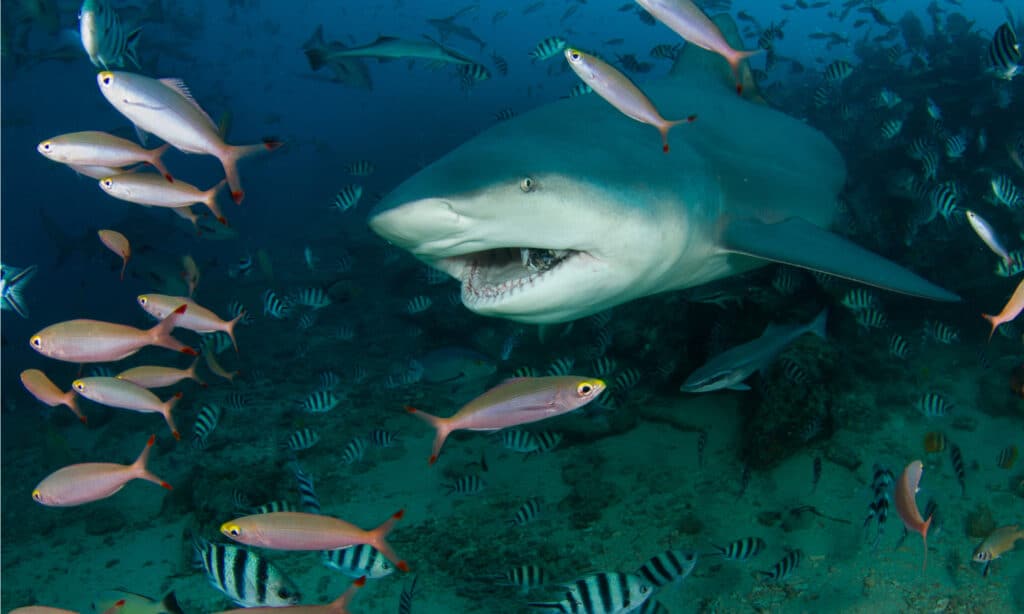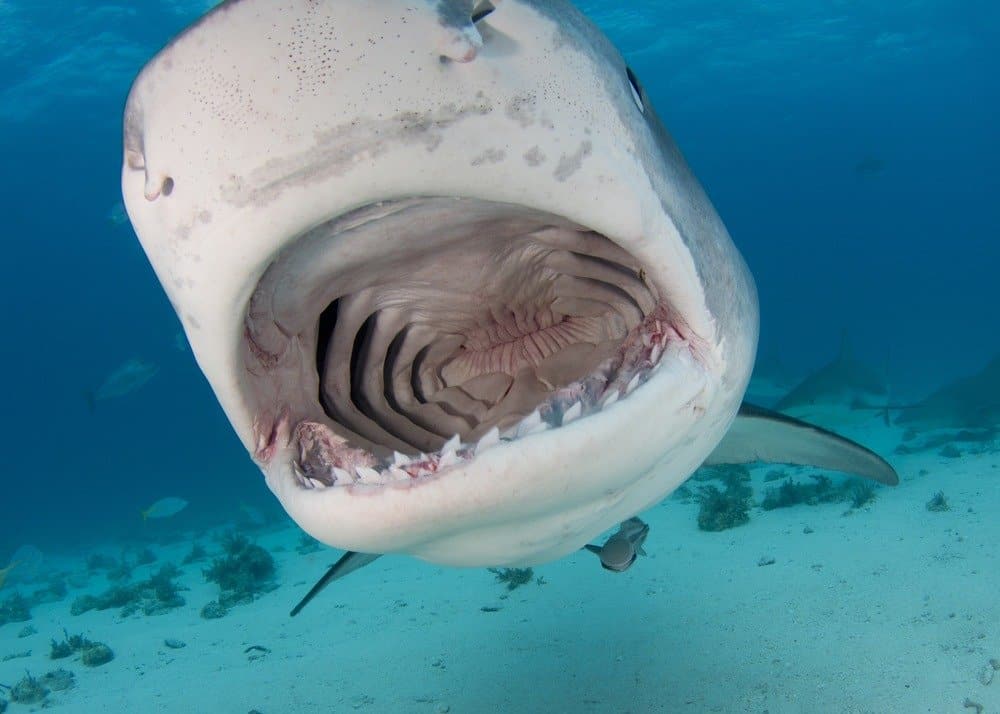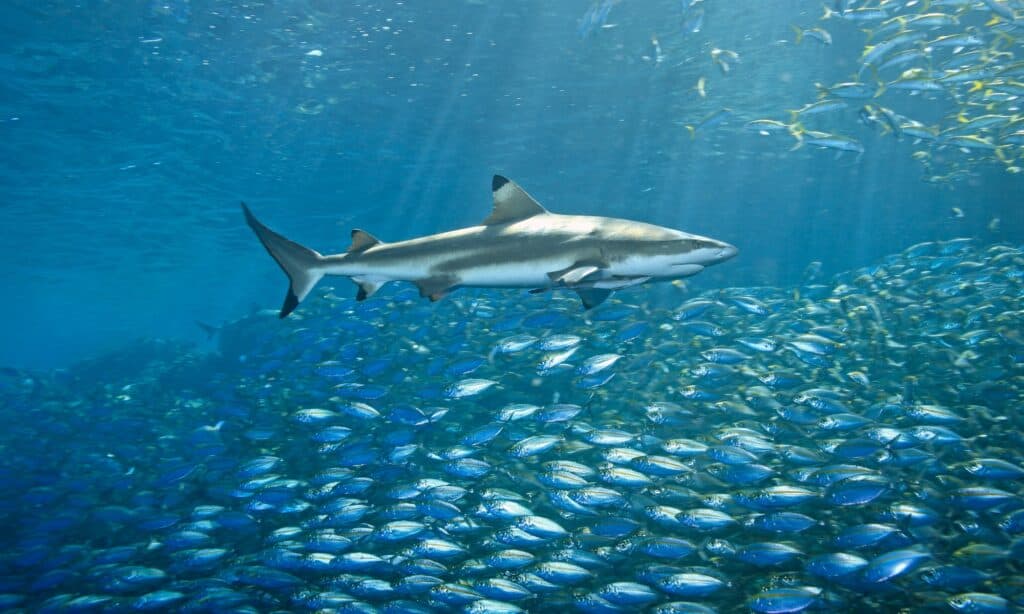
About 19 million years ago sharks experienced an extinction event.
©Xavier ELIAS Photography/Shutterstock.com
Why did sharks almost go extinct millions of years ago?
Around 19 million years, sharks experienced an extinction event. Over 70% of the open water species disappeared altogether – leaving some, preventing full extinction. It’s not 100% clear why the extinction event occurred. However, oceanographers and paleontologists are working hard to uncover some crucial clues.
Why did sharks almost go extinct, and could it happen again? Read on to find out.
Why Did Sharks Almost Go Extinct Millions of Years Ago?
No one knows why sharks almost went extinct millions of years ago. Clues uncovered from denticles are helping to paint a clear picture.
Sharks have unique skin. Instead of traditional fish scales, they have modified scales known as denticles. The micro scales create microfossils, which hold much information about the shark’s history.
The only problem is that denticles are so tiny that they are tough to find. Oceanographers spent many hours hunting for these microfossils from extinct sharks.
What they learned from the fossils was astonishing! The first clues helped explain a change in shark diversity.
Denticles Reveal a Decrease in Shark Species Diversity

After the KT extinction event, almost 30% of shark species disappeared.
©Ramon Carretero/Shutterstock.com
Before the KT extinction, the ratio of sharks to fish was 1:1; for every shark, there was a fish.
After the KT extinction, the ratio of sharks to fish was 1:5, one shark for every 5 fish. The KT extinction event was the one that wiped out the dinosaurs and other prehistoric mammals.
What does this change in shark diversity mean? It helps reveal the journey of the shark’s evolution.
After the KT Extinction event, 30% of sharks were utterly wiped out. For the following 40 million years, the ratio stayed fixed at 1:5. However, 19 million years ago, things changed dramatically!
Sediment core samples from a spot in South Pacific Gyre helped provide a piece of the puzzle. The location hasn’t had a shift with plate tectonics, making it ideal for finding denticles. After taking the samples, researchers were then tasked with the difficult job of examining over 1,000 denticles!
By sorting the denticles by distinguishing features, researchers uncovered 85 different morphological types. Before the mysterious extinction event, there were 10 times more morphotypes of scales than there are today.
The study helped confirm that shark diversity took a significant dive 19 million years ago. Entire species disappeared. If paleontologists can identify the evolutionary role of the different denticle designs, they can learn more about the disappearing ancient sharks. It all comes down to discovering the evolutionary roles of linear vs. geometric denticle designs.
Shark Ancestors and Family Tree

The shark’s fossil history dates back almost 400 million years.
©chatchai kusolsinchai/Shutterstock.com
Sharks have a fossil history that dates back almost 400 million years. This time was the Devonian period or the Age Of Fishes.
Primitive jawless fish began disappearing and in their place came fish with jaws. This included all sorts of primitive armored fish species and the earliest sharks.
Sharks don’t have actual bones in their skeletal structure. Instead, their skeletons are cartilage. Since cartilage doesn’t preserve as well as bone, the shark’s fossil record is a bit murky.
Attempts to reconstruct ancient sharks require tooth fragments and mineralized skeletal elements like denticles. By studying sharks’ fragments, researchers learned about the megalodon, the mega-tooth shark. The species is reminiscent of the mega mouth shark.
Megalodon may have reached an astonishing length of 52 ft. Their teeth may have been almost 7 long! Oceanographers have also discovered individual teeth or bizarre tooth spirals known as whorls. These ancient teeth may have come from Helicoprion, a shark that went extinct 250 million years ago.
Evolutionary Upgrades in Shark Design

Certain evolved shark species have a buccal pump to help them breathe.
©Matt9122/Shutterstock.com
It’s unclear why sharks almost went extinct 19 million years ago. However, the research to discover what happened has uncovered a lot of exciting information about the evolution of sharks.
Take, for instance, the introduction of a buccal cavity. Fish can constantly swim to maintain oxygen levels, or they can use a buccal cavity. For sharks to hunt, and live, they also need optimal oxygen levels.
A buccal cavity pulls a water current through the fish’s mouth and across its gills. The gills are highly adapted to extract oxygen from the water current.
Only a few shark species have the muscular power to run a buccal pump. Certain smaller cat sharks, lemon sharks, and nurse sharks can all lay motionless on the seafloor, thanks to the evolutionary upgrade.
Could Sharks Go Extinct Today?

Sharks are killed for their commercial value.
©iStock.com/cbpix
Could sharks experience another extinction event? Unfortunately, there are a lot of threats that sharks have to deal with. One of their biggest threats comes from humans.
Compared to the 10 to 15 people killed annually, hundreds of millions of sharks perish by human hands annually. Sport, food, and greed are some of the top reasons sharks perish.
A lot of shark products also have commercial value. The skin is used for high-quality leather, and the teeth and jaws are used for different ornaments. Sadly, sometimes a shark will be caught just for its fin. If sharks continue to be mistreated, entire shark populations can collapse.
Why Do Shark Populations Collapse Quickly?
Shark populations are vulnerable to collapse. The reason lies in the life history of these animals. Shark species that don’t produce a lot of offspring are at risk of endangerment.
In a lot of ways, sharks are more like whales and dolphins than they are like other fish. Most fish can produce millions of eggs yearly. Sharks take a different route.
Sharks take years to reach maturity, and they might not reproduce until they’re 15. A single shark might only produce two pups bi-annually. That means sharks average one offspring per year.
An overfished shark species can take decades to recover. In some cases, the shark population may never recover. Their biology is too fragile to withstand exploitation.
How Can You Help Sharks Survive?

Learning about sharks helps keep them alive.
©Olesia Bilkei/Shutterstock.com
There are a lot of ways you can help save sharks all over the world! First, you’ll want to ensure you’re doing your part to reduce, use, and recycle. Everything you do to help the planet will significantly impact ocean life.
You could also look for shark conservation organizations that you can join online. Donating your time is a beautiful way to help spread the word about protecting sharks. Next, do a quick inventory and ensure your household is free of shark products.
Finally, the best thing anyone can do is learn as much as possible about these incredible animals. The more you know about sharks, the more you can share with others! Your passion for learning all about sharks and endangered species can inspire others to do the same.
The photo featured at the top of this post is © Alexyz3d/Shutterstock.com
Thank you for reading! Have some feedback for us? Contact the AZ Animals editorial team.







